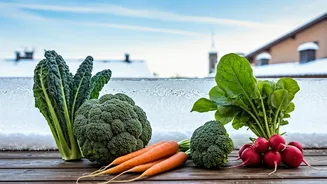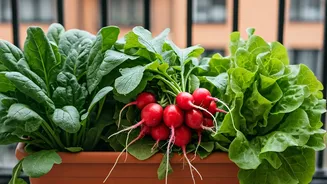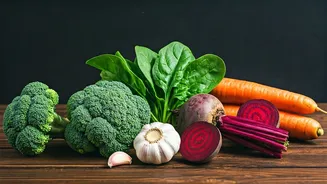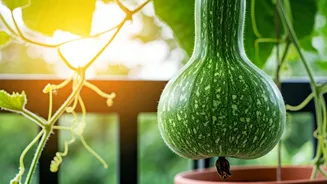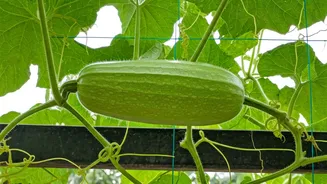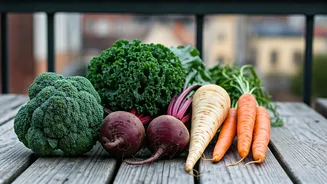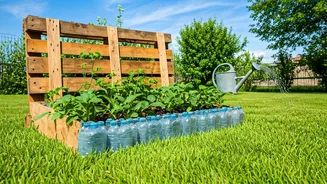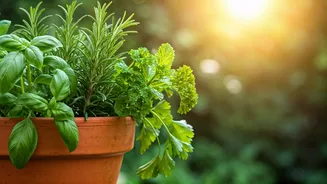Getting Started
Embarking on a balcony garden adventure in winter requires preparation. Start by selecting the right containers; pots with drainage holes work best. Use
a well-draining potting mix, enriched with compost or organic matter to provide essential nutrients. Consider the amount of sunlight your balcony receives; ideally, aim for at least six hours of direct sunlight. Before planting, assess your balcony's microclimate. Protection from harsh winds and extreme cold is crucial. Utilize cloches, row covers, or even a sheltered corner to safeguard your plants. Planning and creating a suitable environment will make your balcony a thriving space for winter vegetables.
Radish: Quick Growers
Radishes stand out as one of the easiest and fastest-growing vegetables for any balcony garden. They thrive in cool weather, making them perfect for winter cultivation. Plant radish seeds directly into the container, spacing them about an inch apart and barely covering them with soil. Keep the soil consistently moist but not waterlogged. Within a few weeks, you'll have a crisp, peppery harvest. Choose varieties like 'Cherry Belle' or 'Early Scarlet Globe' for their rapid growth and excellent flavor. Radishes provide a speedy and satisfying reward for balcony gardeners, offering a fresh addition to your meals.
Spinach: Nutrient Rich
Spinach is a nutrient-dense leafy green that flourishes in cooler temperatures. Sow spinach seeds directly into your containers, spacing them a few inches apart. Lightly cover the seeds with soil and water gently. Spinach requires consistent moisture but benefits from well-draining soil. Consider varieties like 'Baby's Leaf' or 'Bloomsdale' for their tenderness and high yields. With its high vitamin and mineral content, spinach enriches your winter diet. Harvest the outer leaves as needed, allowing the inner leaves to continue growing, ensuring a long-lasting supply from your balcony garden.
Lettuce: Versatile Choices
Lettuce, another cool-season crop, offers versatility in your balcony garden. There are various types of lettuce that you can cultivate. Sow lettuce seeds directly into your containers or start them indoors for an earlier harvest. Space the seeds a few inches apart and lightly cover them. Keep the soil consistently moist and provide ample sunlight. Choose varieties based on your preference. Loose-leaf lettuces, such as 'Black Seeded Simpson' or 'Red Sails,' are easy to harvest and thrive in containers. Romaine lettuce, such as 'Parris Island,' also performs well. Regularly harvest outer leaves for a continuous supply of fresh greens. Lettuce brings both flavor and texture to your meals.
Carrots: Container Success
Carrots can be surprisingly successful in a balcony garden. Select a deep container that is at least 12 inches deep to accommodate their root growth. Choose a loose, well-draining potting mix, free of rocks or debris. Sow carrot seeds directly into the container, spacing them about an inch apart and covering them lightly with soil. Keep the soil consistently moist. Thin the seedlings once they emerge, leaving about two to three inches between plants. Carrots like 'Nantes' or 'Thumbelina' are well-suited for container gardening because they are compact in size and mature quickly. Enjoy your home grown carrots.
Garlic: Easy to Grow
Garlic is an easy to grow addition to any balcony garden. Garlic thrives in cooler temperatures. Plant individual cloves, pointed end up, a few inches apart and about 2 inches deep in a container. Keep the soil moist, but not waterlogged. Garlic needs ample sunlight to flourish. Harvest the garlic when the tops start to turn yellow, usually in late spring or early summer. Varieties like 'Softneck' or 'Hardneck' garlic are well suited for balcony gardening. Freshly harvested garlic can be used in your culinary creations or stored for later use. Garlic adds flavor to any meal.
